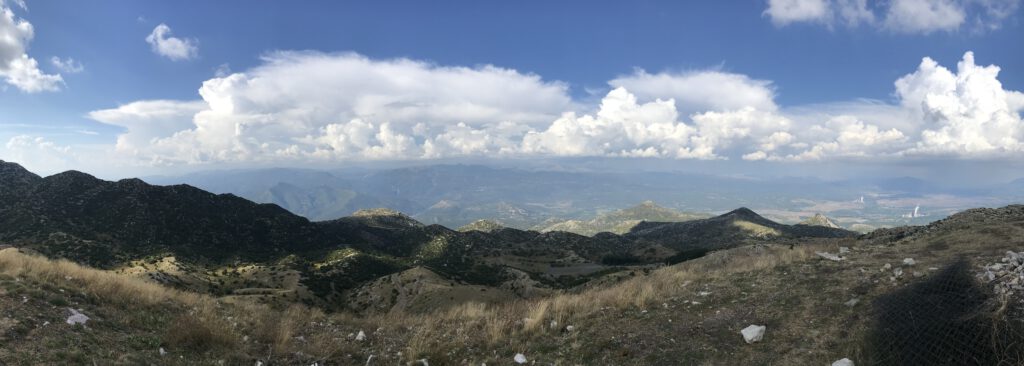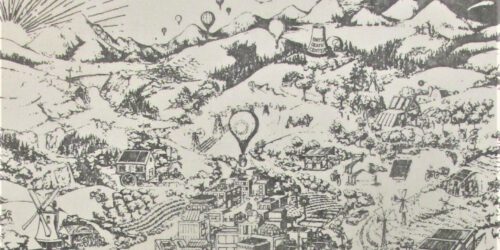Futures Past: The Life, Death, and Future of Energy and Environment in Arkadia, Greece 1950-2023

This post by N. Bucky Stanton originally appeared as part of a series on Environmental Histories of the Future on NiCHE, the Network in Canadian History & Environment.
The framing of modernity, and the sincerity of its consequences, produces a ruptured temporality. Social and ecological appropriation acts tandemly with acceleration into an increasingly uncertain yet possible future of “utopian fulfillment” to alienate the present from the past, the utopian future requiring a dystopic past.[1] One region emblematic of modernity’s temporal and environmental tension is Arkadia, Greece. For more than two thousand years, the region has been viewed through the prism of “Arcadia,” a metaphor for a socially and ecologically balanced utopia. Contemporary Arkadia has followed another utopic image instead: national belonging. A half century of lignite coal mining and burning has blasted the Arkadian landscape and people, leaving the utopic image of Arcadia barely perceptible and its future more uncertain than ever. Yet, 21st century archaeological and environmental futures present opportunities which mediate past and present. To explore how these emerging futures are mending the relationship between past and present, this essay will investigate the social and environmental futures past of Arkadia.


Environment and futurity are central to figurative Arcadia, originating with Virgil’s Eclogues (37 CE) as a paradisaic wild where the poet imagined a capacious society more aligned with the environment and the natural rights of man.[2] These political poetics responded to an early Roman Empire dominated by metropolises rife with social and environmental friction.[3] Arcadia would be later reimagined by Nicholas Poussin in 1637 with his baroque painting Et in Arcadia Ego, translated, “And (even) in Arcadia, I am.” In Poussin’s scene shepherds read the inscription from a tombstone amidst a Edenic natureculture, reminding the viewer of the inescapable and integral purpose of death in life and the futility of searching for a perfect, and changeless, utopia to escape it. For Poussin, no better future can be found than the past that has been lost.[4] Thomas Cole’s romantic painting Arcadian or Pastoral State (1834) presents a landscape of megaliths and primeval forests—intensifying Poussin’s mourning through the frame of American industrialization. In all these uses, Arcadia serves as a reflection of how social and environmental conditions have consequences for the self, society, and future. As the image of Arcadia developed chronologically with modernity it became captured by the increasing estrangement of past and present. In view of this change, what futures past were rendered in modern Arkadia? And what futures are emerging?
The history of Arkadian lignite coal mining began in the aftermath of the Second World War. Mountainous spaces like Arkadia are remembered for a heroic but costly resistance to Nazi conquest, which later became socialist refuges in the subsequent, and asymmetrical, Greek Civil War between communists and “monarcho-fascists” supported by the British and U.S. governments. The Greek Civil War ended with the victory of the monarchist faction, solidifying Greece’s embrace of the Western powers in the Cold War. Despite the supposed victory, the passage from 1940-1949 left Greece in ruins.[5] The economic support of the Truman Doctrine, accelerated century-long social, cultural, and political consolidations post-war.[6] Urbanized elites in Athens governed the resulting Greek nation, and schematized rural areas, such as Arkadia, as spaces of national resource appropriation. With the prewar economy and infrastructures largely destroyed, the state looked within (and under) these peripheries for the energy to fuel Greek modernity.

Albert L. Toenges et al., Bulletin 502: Lignite in Greece (Washington D.C.: U.S. Government Printing Office, 1951).
By 1950, only 30 percent of the country was electrified, the vast majority of which was within Athens and fueled by coal imports.[7] Despite the ruling government’s British and American backing, energy dependence created anxiety for a nation increasingly boxed in by the geopolitics of the Cold War.[8] In 1951, the American Bureau of Mines carried out a study titled “Lignite in Greece,” concluding that lignite coal, a sedimentary rock in the early-stage of coalification, located throughout the borderlands of Greece would be suitable as an domestic power source.[9] Lignite deposits were investigated throughout the South-Western area of Greece, known as the Peloponnese—Kalamata, Sparta, Patras, and Corinth all yielded varyingly suitable deposits.
Founded in 1950, the Dimosia Epicheirisi Ilektrismou (Public Power Company) exercised a state monopoly on power generation and electrification and by 1955 had acquired land with lignite reserves. In 1957, the company “scientifically evaluated” the deposits in the valley outside of the town of Megalopoli in the regional unit of Arkadia. Two earthquakes in 1965-1966 devastated local villages and what scant infrastructure existed. In this precarity, the government believed that lignite would rebuild Arkadia and give this rural area renewed economic purpose as one of few privileged sources of the national lignite-fired growth. The exploitation of the lignite deposits began in 1969, sending power throughout the Peloponnese, to Athens and beyond. This was no small feat as lignite “of such low calorific value” had never been used for power generation anywhere in the world.[10]
In the narrative of the modern Greek state, Arkadia and the Peloponnese are remembered as spaces of triumphant resistance; first against the Ottomans in the Greek War of Independence, and then against the Nazi occupation. Despite this history of resistance Arkadia did not resist modernity, instead embracing their new role as an energy centre for the Greek nation. With lignite came the industrial worker, and amenities such as paved roads, waste treatment, and the consumption economy of the 1970’s. Along with an industrial Arkadia providing the chthonic fire of modernity came the toponymic reshaping of the region in accordance with the new Greek national identity. This identity was constructed by the Athenian intelligentsia explicitly in conversation with the role of Greece in the Western historical imaginary, portraying a continuous ancient to modern Greek identity which lay claim to the grandeur of old and the present power of that image.[11] The Peloponnese had not always been a purely Greek place, and consequently, Arkadia and its surrounding regions featured non-Greek place names, including many of Turkish or Slavic origin. The burning of lignite brought not only industrial modernity to an isolated region but also the ideology of this new national homogeneity, as “barbarous” non-Greek place names were replaced with appropriately “classical” names.[12] A new future, required a new past.
Strong economic growth persisted into the 1980s, as the Megalopoli mine was expanded and a new power plant was built.[13] Growth soon began to stagnate, as costs mounted and the easily sourced high quality deposits exhausted. The power plants burnt increasingly low-energy (wet) lignite, which lowered the overall efficiency of power generated —affecting both profits and local employment. In the 1990s the health and social effects of lignite pollution, along with the devastation of local farmland by surface lignite mining, resulted in a demographic and environmental crisis. Several villages were swallowed up by the expanding strip mines as miners sought out new deposits. Decades of mining rendered the Megalopoli Basin a moonscape of gray hills and craters—the air was thick with black smoke, water was contaminated with runoff, and the lungs of locals were full of soot.[14] The globalized economy of the early 2000s accelerated these issues, as economic forces lured younger generations towards urban areas, technocratic expertises, and market liberalism. In 2001, Greece was among of the first countries to adopt the Euro as it is currency.

Counter to expectations, global interconnectivity denied Greece monetary agency and provided hollow consumption-heavy growth.[15] Elites performed well in the new international business environment, but the working class was forced to cling to pension structures and government services as prices skyrocketed and wages stagnated. In this transnational cacophony, the government liberalized electricity with hopes of lowering costs.[16] The monopoly of the state on power generation was over. New or partial private ownership of many lignite mines caused mass unemployment or increasingly more precarious contract work. As the Great Recession brought severe austerity after 2009, wages deflated rapidly, public institutions were withered or privatized, and long-term positions in lignite mining dwindled. Despite being a central part of the modern Greek economy, lignite hires since the recession have been increasingly short term contracts lacking healthcare, pensions, or other previously implicit worker support programs.[17]
Since the mid-2000s, lignite, and by extension Arkadia, has been locked in a holding pattern of survival common to places caught in the riptides of resource extraction. The Megalopolian Valley is ecologically destroyed after decades of mining with only ruderal grasses able to recolonize barren hills. Lignite coal reserves are dwindling, but lignite production continues, despite climate regulations enacted by the European Union.[18] The current government coalition, headed by the liberal-conservative New Democracy party, has moved ahead with plans to close down the lignite facilities across the country, including the facilities in Arkadia, in 2023. Local workers and communities tried to protest this closure due to the economic impacts but have little agency in the liberalized energy market where once monopolistic state agencies compete with private forces.[19]
Arkadia’s future, however uncertain, is marked by the hope that lignite’s death could give way to new life. Largely ignored by tourists and researchers in favour of coastal and metropolitan sites, Arkadia has recently undergone an archaeological resurgence centered on the Sanctuary of Zeus at Mt. Lykaion.[20] Galvanized by Mt. Lykaion’s ongoing success, a plan to establish the Parrhassian Heritage Park has become a reality after decades of work between the Arkadian Ministry of Culture and the American directors of the Mt. Lykaion Excavation and Survey Project.[21] This park attempts to cross provincial borders and secure the entire space of what was once ancient Arcadia. While the park focuses on archaeological sites and possibilities of more deeply probing the Arkadian hinterlands, an equally important objective is the protection of the natural and cultural landscape for a sustainable tourist economy. However, new plans by the government to cover the mountainous terrain with wind turbine infrastructure will fragment environments, intervene in the symbolic landscape of the region, and threaten the imagined sustainable heritage and tourist future for Arkadia.[22] After proudly enduring as a lignite center, Arkadia is once again called upon to be an energy periphery, however, the future associated with wind power offers uncertainty without utopian aspiration.

The history of modern Arkadia offers a clear example of past and present in modernity. While lignite mining brought ideological and economic changes, it hardly provided the “utopian fulfillment” anticipated.[23] Current and predicted environmental, social, and economic issues in Arkadia make clear that utopia remains far off. Nonetheless, emerging heritage futures offer hope and insight for reconciling the present and past. Parrhassian Heritage Park accepts all the landscapes of Arcadia and Arkadia, providing an afterlife to lignite. While further energy exploitation looms, reweaving past and present through imagining a sustainable heritage future fulfills at least part of the dreams of Arcadian futures past.
[1] Reinhart Koselleck, Futures Past: On the Semantics of Historical Time (New York, NY: Columbia University Press, 2004), 19.
[2] Virgil and Guy Lee, The Eclogues, Rev. ed (Harmondsworth and New York, NY: Penguin, 1984), 1-20.
[3] J. Donald Hughes, Environmental Problems of the Greeks and Romans: Ecology in the Ancient Mediterranean (Baltimore, MD: Johns Hopkins University Press, 2014), 101, 191.
[4] Erwin Panofsky, “Et in Arcadia Ego: Poussin and the Elegiac Tradition,” in Philosophy and History: Essays Presented to Ernst Cassirer (Oxford: Clarendon Press, 1936), 295-320.
[5] Amikam Nachmani, “Civil War and Foreign Intervention in Greece: 1946-49,” Journal of Contemporary History 25, no. 4 (July 1990): 1.
[6] Harry S. Truman, “Address Before a Joint Session of Congress” (March 12, 1947).
[7] Marina Emmanouil, “Naturalising Electricity in Greek Advertising: Transitions between Past and Present in Identity Crafting, 1954-62,” in Proceedings of the 9th Conference of the International Committee for Design History and Design Studies (9th Conference of the International Committee for Design History and Design Studies, Aveiro, Portugal: Editora Edgard Blücher, 2014), 1.
[8] Stathis Arapostathis and Yannis Fotopoulos, “Transnational Energy Flows, Capacity Building and Greece’s Quest for Energy Autarky, 1914–2010,” Energy Policy 127 (April 2019): 39-50.
[9] Albert L. Toenges et al., Bulletin 502: Lignite in Greece (Washington D.C.: U.S. Government Printing Office, 1951).
[10] The lignite at Megalopoli is often closer to peat than to hard anthracite coal traditionally represented as “coal” in popular energy imagination. Ilias Kordas J., “Lignote as Contributory Factor to Regional Development of Greece: The Case of Megalopolis Basin at Central Peloponese,” in Enlargement, Southern Europe and the Mediterranean (46th Congress of the European Regional Science Association, Volos, Greece, 2006), 4-5.
[11] Yannis Hamilakis, The Nation and Its Ruins: Antiquity, Archaeology, and National Imagination in Greece (Oxford: Oxford University Press, 2009); Johanna Hanink, The Classical Debt: Greek Antiquity in an Era of Austerity (Cambridge, MA: The Belknap Press of Harvard University Press, 2017).
[12] Hamilakis, The Nation and Its Ruins, 41.
[13] Arapostathis and Fotopoulos, “Transnational Energy Flows, Capacity Building and Greece’s Quest for Energy Autarky, 1914-2010,” 45.
[14] Apostolos Sarris et al., “Environmental Study for Pollution in the Area of Megalopolis Power Plant (Peloponnesos, Greece),” Environmental Geology 58, no. 8 (October 2009): 1769-1783; A. Papagiannis et al., “Externalities from Lignite Mining-Related Dust Emissions,” Energy Policy 74 (November 2014): 414-424.
[15] Panagiotis Sotiris, Crisis, Movement, Strategy: The Greek Experience (Leiden: Brill, 2019), 40-43.
[16] Nikolaos Danias, John Kim Swales, and Peter McGregor, “The Greek Electricity Market Reforms: Political and Regulatory Considerations,” Energy Policy 62 (November 2013): 1040-1047; Ekaterini N. Iliadou, “Electricity Sector Reform in Greece,” Utilities Policy 17, no. 1 (March 2009): 76-87.
[17] J.K. Kaldellis, D. Zafirakis, and E. Kondili, “Contribution of Lignite in the Greek Electricity Generation: Review and Future Prospects,” Fuel 88, no. 3 (March 2009): 475-489; C. Tourkolias et al., “Employment Benefits of Electricity Generation: A Comparative Assessment of Lignite and Natural Gas Power Plants in Greece,” Energy Policy 37, no. 10 (October 2009): 4155-4166.
[18] “New EU Emissions Laws,” ClientEarth (2019).
[19] “PPC Workers Walk out in Protest at Labor Reform,” Kathimerini English (November 28, 2019).
[20] David Gilman Romano and Mary E. Voyatzis, “Mt. Lykaion Excavation and Survey Project, Part 1: The Upper Sanctuary,” Hesperia: The Journal of the American School of Classical Studies at Athens 83, no. 4 (2014): 569; David Gilman Romano and Mary E. Voyatzis, “Mt. Lykaion Excavation and Survey Project, Part 2: The Lower Sanctuary,” Hesperia: The Journal of the American School of Classical Studies at Athens 84, no. 2 (2015): 207; Romano and Voyatzis, “Sanctuaries of Zeus: Mt. Lykaion and Olympia in the Early Iron Age,” Hesperia: The Journal of the American School of Classical Studies at Athens 90, no. 1 (2021): 1.
[21] David Gilman Romano and Mary E. Voyatzis, “The Parrhasian Heritage Park of the Peloponnesos.”
[22] “Installation of 72 wind turbines in areas of natural beautiy and archaeological sites of Messinia, Ilia and Arcadia,” Messinia Live (February 8, 2021).
[23] Koselleck, Futures Past, 19.
*Cover image: View of Megalopolis Basin from Upper Sanctuary at Mt. Lykaion. Photo by author.






1 Response